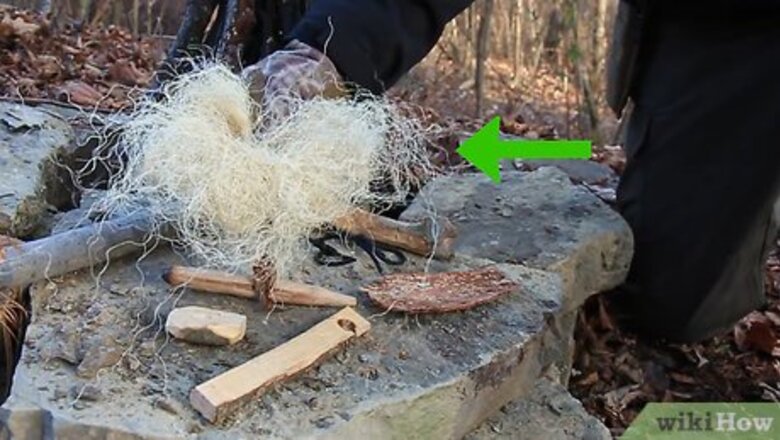
views
Gathering the Tinder and Firewood
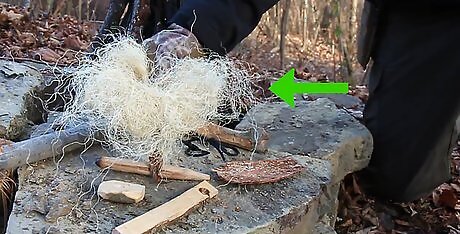
Find tinder. There are a few different methods for starting a fire with sticks, but whichever method you try you are going to try, begin by gathering together the tinder and firewood that you will be burning. For tinder, anything that is dry, fibrous, and will take a spark or catch and ignite should do. Pocket lint, feather down, dried mosses, and shredded plant fibers such as cedar bark are all good examples. You should try to get a tinder bundle that is very dry and fine. The tinder bundle is the first thing that you will burn.
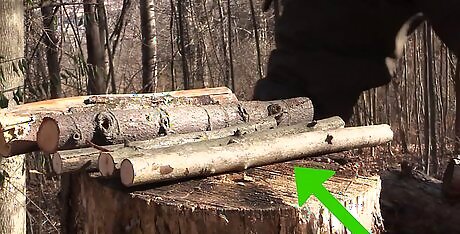
Gather kindling. You will also need to gather together the kindling, which you will add to the tinder once you have the beginnings of your fire. Gather several handfuls of kindling, typically tiny pieces of wood in various sizes. You want some that are as thin as or thinner than a toothpick but longer; several handfuls of wood about the thickness and length of a pencil; and lots of wood up to about the thickness of your arm. Avoid using wood that was on the ground since it may be damp. Instead, look for snags (dead branches that have fallen off trees but get caught in lower branches or on bushes). It is possible to snap dead branches from trees, but only take those that immediately snap free. Otherwise, they may not, in fact, be dead. If a branch bends without breaking, it's still alive or not dry enough. Avoid green wood since most won't burn well.
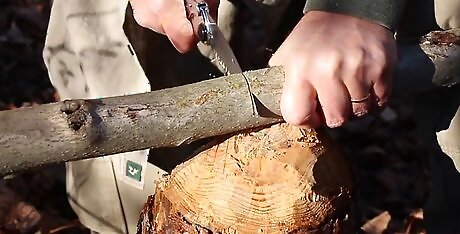
Find some larger firewood. Once your fire is up and running you will need to add some larger pieces of firewood to keep it fueled. It’s a good idea to get yourself a large stack of wood ready to use before you try to light the fire. This wood should be larger than the kindling and only added once your fire is established. This wood must be as dry as possible. Dead trees are often a good source of dry firewood. When you collect the wood, try to avoid putting it directly onto the ground if it is wet.
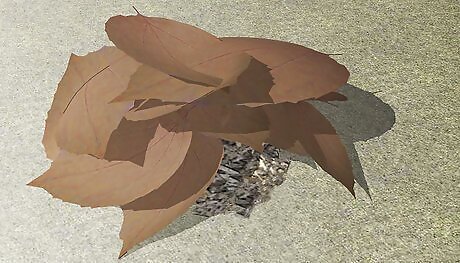
Make a tinder nest. Whichever method you use to get your spark, you will need to make a small nest with your tinder. This is also known as a tinder bundle. Once you have a spark or some coals, you will transfer these to the nest to get the first flames. Bunch together a small ball of your tinder, around the size of a cotton ball, with small fibers, such as cattail plant at the center. You can use some slightly thicker fiber on the outside, such as dry leaves, to shelter the nest. Make sure you make a hole or indent with your thumbs for the coal. Try to fashion the tinder bundle into a shape similar to a birds nest. You can use a strip of bark wrapped around the bundle to hold it together.
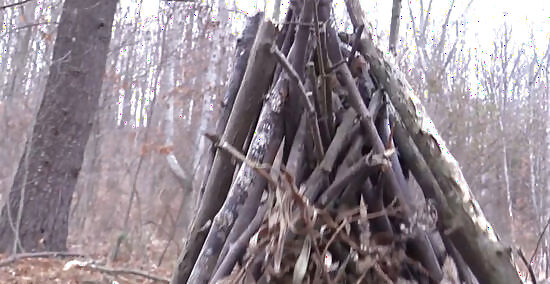
Make a teepee or "house" out of wood. Before you start to work on getting your spark or coals, you can build up some of your firewood into a teepee shape. Arranging a cone of your fuel, with lots of timber in the middle, and larger sticks around the sides, can help your fire to establish and grow. Don’t overload the teepee, and remember to leave plenty of space so that air can pass through it and feed the flame.
Making Your Tools and Materials
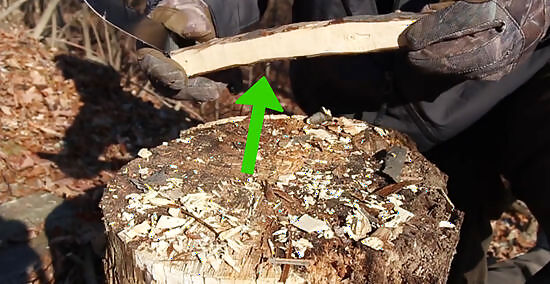
Get a fireboard. If you are using either the hand drill or the bow drill method, you will need to first prepare your fireboard. This is what you will press the drill against to create the friction that will hopefully start your fire. The fire board and the drill both need to be made from light, dry, non-resinous wood. The best wood for this won't have any sap and will be light and soft enough to easily dent with your thumbnail without gouging. Shape whatever wood you choose into a piece about an inch thick, 2-4 inches (5-10 cm) across and at least 12 inches (31 cm) long.
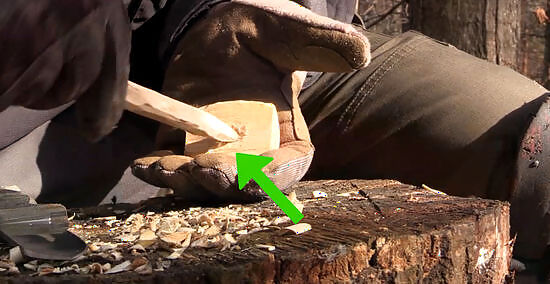
Make a drill. Once you have your fire board you will need to make your drill. Your drill should be made of harder wood than your fireboard. Poplar and Maple are good woods for this. Try to find the straightest piece of wood possible, and carve it down to a length of around 8 inches and a diameter of about 1.5 inches. Carve one end of the stick into a tapered point, like the end of a pencil. Carve the other end into a blunt point.
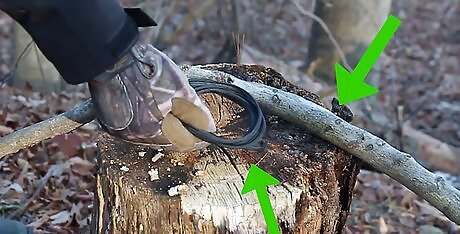
Make a bow. If you are trying the bow drill method, now is the time to make your bow. Use slightly flexible wood for this, as you'll be exerting a lot of pressure on the bow and dead wood is more likely to break than similarly sized green wood. Green or dead wood can, however, both work as a bow. Make a bow that is approximately the length of your arm, and has a diameter of one or two inches. Use as thin a piece of wood as you can so the bow will be as light as possible. A lighter bow is easier to control and takes less strength to push back and forth. However, it has to be stiff enough to not bend when you're using it.
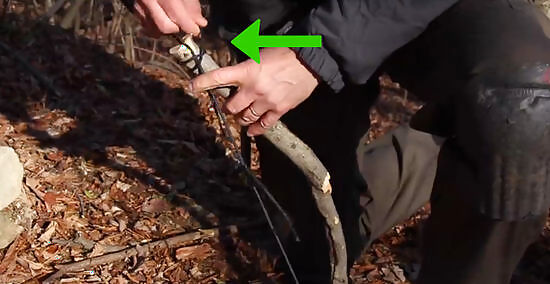
Attach the bowstring. Use a shoelace, drawstring, small rope or whatever cordage you can find for the bowstring. Natural materials such as dogbane and nettle were traditionally used to make bowstrings. Cut a length that is around six feet long, and tie one end of the cordage tightly to one end of the bow. Tie the other end of the string on with a looser an adjustable knot so that you can alter the length and tension of the string.
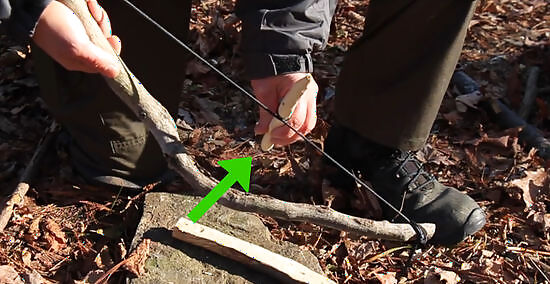
Adjusting the string. It's important to keep the string tight so that it doesn't slip on the drill. However, if it's too tight, it will make the drill pop out of the socket or the fire-board. There are a number of ways to deal with the string adjustment. Get the string almost tight enough, hold it at the very end of the bow and then squeeze the string up against the bow as you start to saw back and forth if needed. Even if you get the string just right at first, it will often loosen up as you're sawing back and forth, so this is a good technique to master. You may need to work your hand up the bow to get the string tight enough as you go. To keep the cord firm, you might have to loop it around your finger(s) or adjust it by tying a tighter knot. Another way to keep it tight is to put another stick (preferably thick, as this method can snap smaller sticks) in another loop, near the end. Twirl it around and around until you reach the desired tightness and then 'lock' it against the bow. If it keeps slipping, hold that end in your hand.
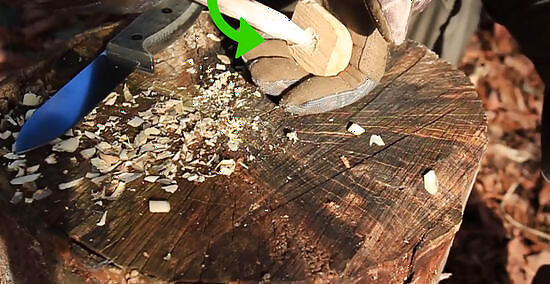
Find or make a socket. The socket, sometimes referred to as the handhold, is the thing you will use to exert extra downwards pressure on the drill, Typically it is a small object with a hole or notch in that you place on the top of drill and push down on. Your socket can be made of bone, wood or rock. Look for a rock with a smooth dimple in it. Ideally, the rock should be about fist sized. It should fit easily in your hand but not be too small or it can heat up very quickly. The ideal rock has a deep dimple with smooth sides. If you can't find a rock, the easiest socket to make is wood. It should be small enough for you to comfortably hold in your hand, but big enough that your fingers don't wrap all the way around it and touch the drill. It is best to make the socket out of hardwood if possible or use a knot in softwood as a naturally lubricated socket. Use the tip of a knife or sharp rock to drill a hole no more than halfway into the wood. You can also improvise a socket from many other materials. Look for things that will keep the narrow end of the drill stable, but still allow it turn easily. Of course, other things can be used as sockets. Lubricating the socket with lip balm or resin is a good practice.
Preparing the Fireboard
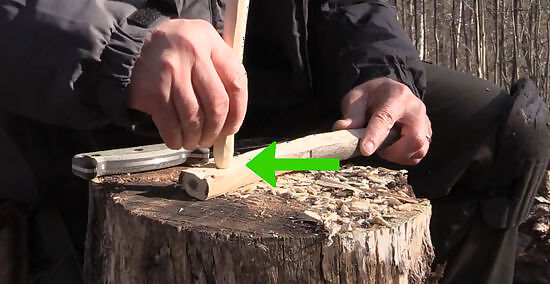
Carve a small hole in the fireboard. If you have already drilled a hole in your fireboard before you set off into the wilderness, you won’t need to do this step. If, however, you are making your fire board from scratch, you will need to the make the hole which you will then insert the drill into. Carve a small hole with your knife, about an inch from the edge of the board. The hole should be the width of your drill and about a quarter of an inch deep. When you push down on the drill it should be difficult to turn it. You should feel strong friction.
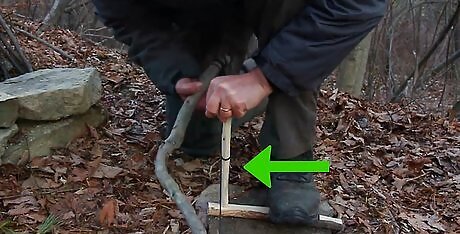
Use the bow drill to burn the hole. Once you have carved a small hole, you can use your drill to make this into a better shape to create friction and fire. You can do this by drilling into the hole and burning it with friction. Once you have made this hole, you will be able to re-use it in the future when you want to start a fire with sticks. Note that the following steps are written from the perspective of a right-handed person or "rightie"; it would be the reverse for "lefties". Put the fire board on the ground. Put your left foot on the fire board about one inch to the left of the crater. The arch of your foot (not the ball or the heel) should be over the fireboard. Make sure the ground is pretty flat or bed the fire board into the ground. You don't want it to wiggle or rock much, if at all. Kneel on your right knee. Make sure that your right knee is far enough behind your left foot that you make all 90-degree angles. (More about that later.) Hold the bow in your right hand and the drill in your left. Put the drill on top of the string with the pencil-sharp end pointing right, and twist it into the bow. You can loosen the string a bit if it's too hard to do, but the string must not slip once wrapped around the drill. Put the blunt end of the drill on the crater. Put the socket on the drill. Grab as close to the end of the bow as you can. Put some downward pressure on the socket and start to pull back and forth on the bow. It's a delicate balance between putting too much and not enough pressure on the drill, and having the bow string too tight and not tight enough. Saw back and forth with the bow faster and faster, and put more and more pressure on the socket. Eventually, you'll get some black powder and smoke around the bottom of the drill. This is a good sign! Stop and pick up the fire board.
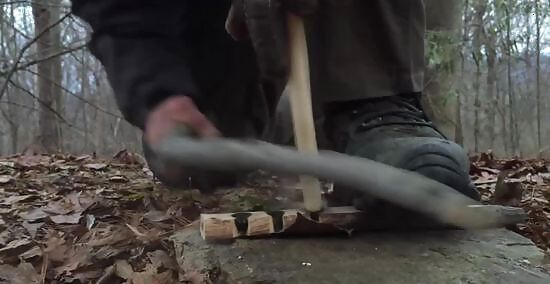
Burn the hole with a hand drill. If you are not using a bow, you still have to burn the hole into the board. You can do this by using your hands to turn the drill and create the friction in the same way that the bow does. Place the drill between your hands and run your hands backward and forwards to spin it. Ensure that you are keeping downwards and inwards pressure on the drill all the time. You will find that this leads to your hands moving down the drill as you go. It’s important to keep it turning, so when your hands are near the board move them back up to the top of the drill quickly. Keep going until you see smoke. This can be a long and arduous process, so have patience and stick with it.
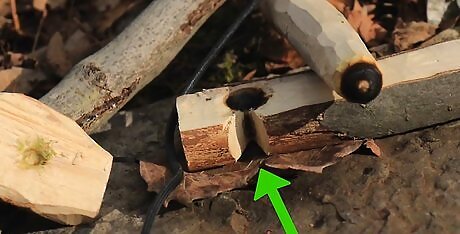
Cut a chimney notch. Use your cutting device to make a V-shaped notch that reaches from the edge of the fireboard almost to the center of the hole you just burned in the fireboard. The most important thing is to make sure that it's not so wide that when you start spinning the drill in the hole again it just slips out through the notch. The notch should be the size of about 1/8 of a pie slice. The narrow end of the slice should meet the center of the hole you have burned into the wood. The wide end should face outwards away from the hole. The notch and the drill end that goes into it should both be rough, not shiny and smooth. The roughness promotes friction. If they get shiny, put a little sand in the notch.
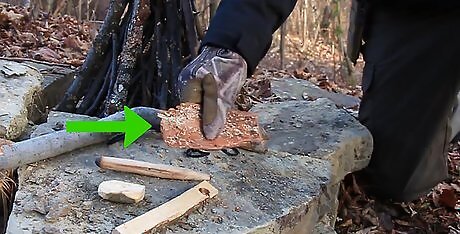
Position a coal catcher. You need something to catch the coal that's created, keep it insulated from the cold ground and carry it from the ground to the tinder. This can be a dry leaf, sliver of wood, piece of paper or bark, among other options. Whatever it is, make sure you can pick it up without fumbling around and dropping it. Place it directly under the notch you have cut in the fire board before you try to make coal.
Starting The Fire
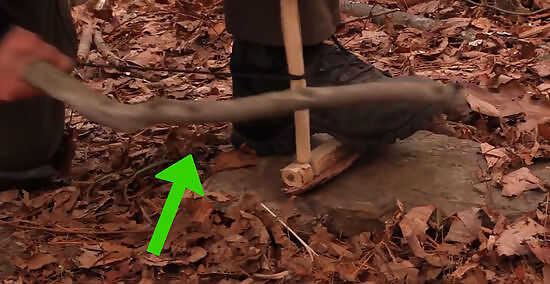
Make a coal using a bow. Now it's time to make fire! You do everything the same way you did when you burned a hole in the fireboard. Don't forget to put your coal catcher under the chimney notch, and have your tinder bundle ready. Start pushing and pulling on the bow, and pushing down on the socket. As you get into a rhythm, saw faster and put more pressure on the socket. Keep the bow in the middle of the drill. If the string moves up the drill, it will create more horizontal force up near the socket and will be more likely to pop out. The bow string should always be horizontal to the ground (if the ground is perfectly flat) and perpendicular to the drill. This ensures that every stroke of the bow is providing the maximum amount of "output" and as a result, lessens fatigue on your body--using a bow drill is hard work! Eventually you'll get black powder collecting in the chimney notch. Keep going and you'll get some smoke. When you've got a lot of smoke coming out, don’t stop. Increase the pressure and the speed of your drilling. Look at the dust you are creating. The darker the dust the better. If you are getting smoke from your dust pile, it is likely that you have a coal.
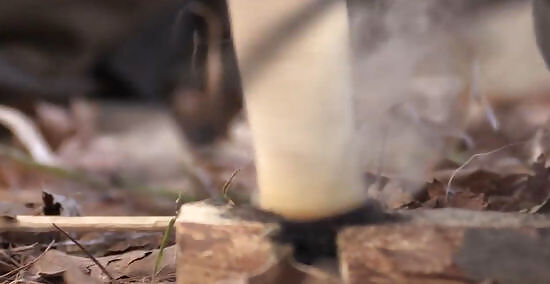
Use a hand drill to make coal. If you are using your hands, repeat the hand drilling technique you used to burn the hole in the fireboard. Using your hands rather than a bow is generally slower and harder work, but you can get a coal if you stick with it. Move your hands backward and forwards rapidly across the drill, and don’t let up the downwards pressure onto the fire board. Try to keep your hands towards the top of the drill by moving them in a half circle or arc motion. The lowest point of the arc should be the point where they run against the drill.
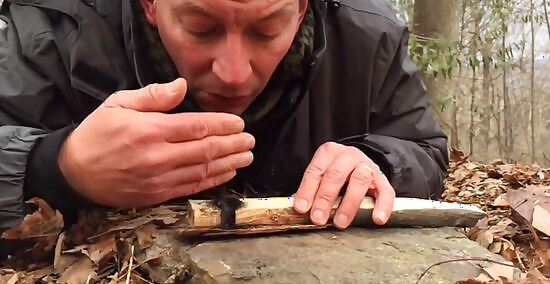
Blow the coal into flame. Once you have a coal, carefully remove the drill and lift away the fire board, using a twig to hold the new ember down if it gets stuck in the notch. Use one hand to gently fan air over the coal, making it bigger and more solid. Don't blow on it unless you blow very gently, as you might knock it off the coal catcher. If the ground's wet, it'll put the coal out. You might also put it out if you have to pick it up off the ground. Once you're sure the coal isn't going to go out, transfer it to your tinder and give it a gentle blow.
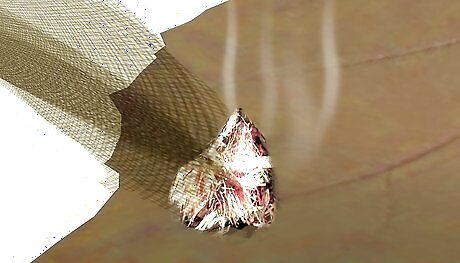
Blow through the tinder bundle. Begin blowing softly through the bundle while gently squeezing the tinder around the coal. As more tinder catches, you might have to turn and/or reshape it to keep the ember spreading into more and more of the tinder. Blowing will provide more oxygen to stoke the fire and transfer the energy from the coal to the tinder bundle.
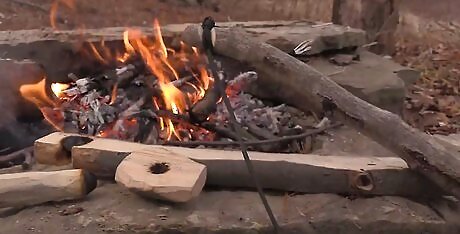
Build your fire. Continue blowing and gently squeezing with the tinder bundle until you get actual flames. Put it on the ground where you want your fire. Keep blowing if you need to keep the flames going. Add the toothpick size sticks on top of the bundle, then the pencil sized sticks, followed by increasingly bigger items until you have your campfire. If you have prepared a teepee-type fire put the burning tinder bundle into the center. Keep blowing slowly and steadily to help spread the fire.




















Comments
0 comment